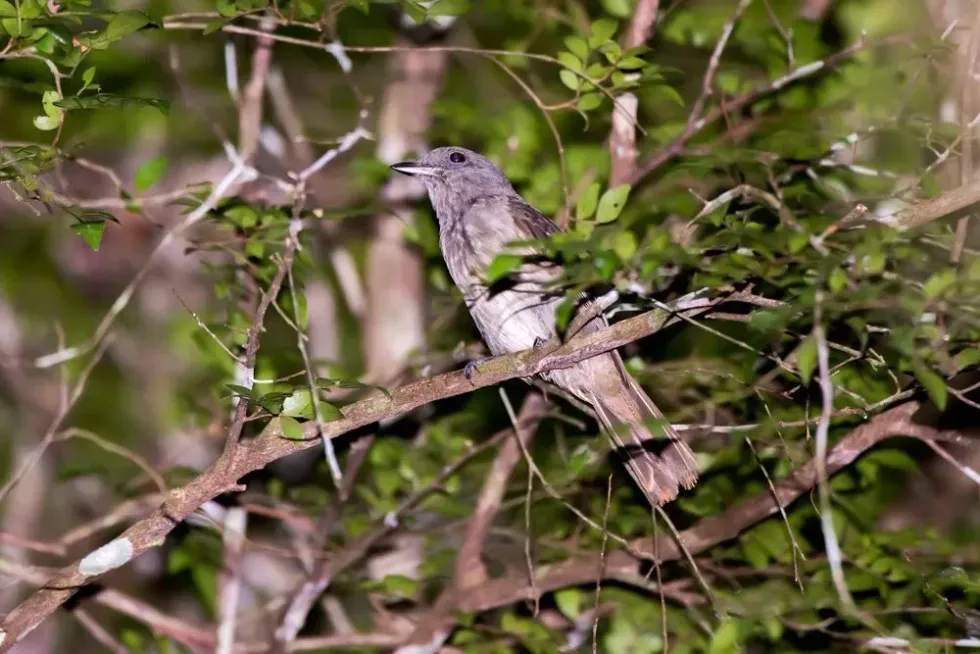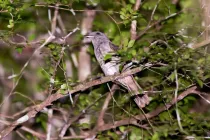The cinereous mourner (Laniocera hypopyrra) is a type of bird found in the Amazon rainforest of South America, belonging to the family Tityridae. These unique birds are known for the poisonous caterpillar-like appearance of their chicks, which sport fluffy, orange plumage.
This is a phenomenon known as Batesian mimicry, in which harmless creatures tend to mimic more poisonous or dangerous ones in order to keep predators away. In dangerous places such as the Amazon rainforest, this mechanism helps such bird species to survive and grow.
Not much is known about these birds aside from the fascinating appearance of their nestlings. They are a part of the intricate ecosystem that is the Amazon rainforest, and their unique defense mechanism is what makes them stand out.
To learn more about these magnificent birds, read on! For more relatable content, check out these Jandaya parakeet facts and Amazon parrot facts for kids.
Cinereous Mourner Interesting Facts
What type of animal is a cinereous mourner?
The cinereous mourner (Laniocera hypopyrra) is a type of unique bird species whose nestlings resemble large, hairy caterpillars. It belongs to the family Tityridae.
What class of animal does a cinereous mourner belong to?
The cinereous mourner (Laniocera hypopyrra) belongs to the class of Aves.
How many cinereous mourners are there in the world?
Though the exact number of cinereous mourners, of the family Tityridae, in the world is currently unknown, we can assume that their population is thriving in the rain forests due to their IUCN Red List status of Least Concern.
The unique appearance of their nestlings plays a huge part in this, with predators being deterred by their poisonous caterpillar-like appearance.
Where does a cinereous mourner live?
The cinereous mourner can mainly be found on the continent of South America. It makes its home in the rainforests of Bolivia, Colombia, Brazil, Peru, Venezuela, and Ecuador.
What is a cinereous mourner's habitat?
Being a South American tropical bird, the cinereous mourner of the family Tityridae is a common inhabitant of subtropical and tropical moist forests which lie at sea level. Their preferred habitat is rainforests, notably the Amazon rainforest.
Who do cinereous mourners live with?
The cinereous mourner is a solitary bird and can usually be found alone, however, it can be found in pairs during the breeding season. These birds usually form mixed-species flocks during the day in order to hunt for food.
How long does a cinereous mourner live?
Unfortunately, there is no available information on how long these birds can live.
How do they reproduce?
Cinereous mourners are oviparous in nature, meaning the females lay eggs that hatch into young birds. The breeding period of these birds occurs from September to November, during which the birds can be found pairing up and building nests.
The nests are cup-shaped and built out of twigs, roots, and grass, often located high up in trees where predators are unlikely to spot them.
After mating, the females lay eggs that hatch into nestlings. The mother then feeds the caterpillar-like chicks for about 18-20 days, until their defensive plumage has shed and they are ready to leave the nest.
What is their conservation status?
The current conservation status of these tropical birds as a species is of Least Concern, as they are a common species of the rainforests of South America, and can be found nesting in various trees.
Cinereous Mourner Fun Facts
What do cinereous mourners look like?
 *We've been unable to source an image of a cinereous mourner and have used an image of a speckled mourner instead. If you are able to provide us with a royalty-free image of a cinereous mourner, we would be happy to credit you. Please contact us at hello@kidadl.com.
*We've been unable to source an image of a cinereous mourner and have used an image of a speckled mourner instead. If you are able to provide us with a royalty-free image of a cinereous mourner, we would be happy to credit you. Please contact us at hello@kidadl.com.
The adult cinereous mourner (Laniocera hypopyrra) looks like any other typical bird, with its downy brown-gray feathers tipped with orange, which cover its entire body. It is a small-sized bird, with large eyes ringed with yellow and a black bill and feet.
However though alone it may look quite attractive, compared to its chick it looks almost drab in appearance.
At first glance, the cinereous mourner chick looks not like a bird at all but like a toxic caterpillar, namely the Megalopygidae caterpillar, which has an orange, hairy appearance.
These chicks mimic these caterpillars through harmless Batesian mimicry, in order to evade the many predators of the Amazon.
Upon being born, the chicks are covered with downy, orange feathers which are tipped with black spots and protruding white barbs, giving them an exotic appearance. The chicks lay face down in their nests when the mother bird is out and move their bodies slowly from side to side, fully completing the transformation from bird to insect.
Once their mother returns with food in beak, they emerge as fledglings once again, breaking the illusion.
How cute are they?
Despite the fact that cinereous mourners mimic long toxic caterpillars, the fluffy orange chicks are very cute in appearance. The adults themselves have a quite regal look as well, with their all gray-black feathers tipped with orange.
How do they communicate?
The cinereous mourner (Laniocera hypopyrra) has a low whistling call, which can be described as 'whee-oo-wee' tweeting sound.
How big is a cinereous mourner?
The cinereous mourner adult measures around 8.3 in (21 cm) in length, whereas the juvenile caterpillar-like bird measures around 4.7 in (12 cm). The adult birds are bigger than horned larks.
How fast can a cinereous mourner fly?
Though there is not much information available on how fast this bird can fly, we can be sure that living in the Amazon rainforest means that this bird has to always be on its feet.
Being fast of flight is essential to survive in a forest full of predators, and owing to the abundant population of the cinereous mourner, we can assume that it has adapted to become quite fast.
How much does a cinereous mourner weigh?
These birds have been observed to weigh between 1.4-1.8 oz (41-51 g) and are bigger than chimney swifts.
What are the male and female names of the species?
There are no special names for either male or female birds of this Amazonian bird species.
What would you call a baby cinereous mourner?
A baby cinereous mourner bird is known as a chick, hatchling, or fledgling, though one might mistake it for a caterpillar instead due to its hairy plumage!
What do they eat?
These birds are insectivorous in nature and feed on a variety of insects found in the Amazon such as beetles, grasshoppers, moths, ants, etc.
Are they dangerous?
No, despite the mourner cinereous chicks' toxic caterpillar-like appearance, these Amazonian birds are quite harmless. Though, like with all other wild birds, it is best not to approach them or their nests if they are found, as they might attack in self-defense.
Would they make a good pet?
Seeing as these are wild birds, it is not recommended to keep them as pets. Many common wild bird species, especially tropical ones, may not be able to adjust to urban conditions which may lead to an array of health problems leading to premature death.
Hence it is better to observe this caterpillar-like bird species from afar and do whatever we can to help preserve their natural habitat, the rainforests.
Did you know...
The cinereous mourner (Laniocera hypopyrra) is a resident bird of South America and does not migrate.
Due to their unique defense mechanism of mimicry, their population in the forests is booming and they are in no danger of becoming vulnerable at all.
How did the cinereous mourners get their name?
The Amazonian cinereous mourner (Laniocera hypopyrra) bird species of the family Tityridae has been named after its ashy gray plumage. The word cinereous means 'cinder' or 'ash' in Latin, to which its dull feathers can be compared.
What's unique about cinereous mourners?
The most unique attribute of this bird species is definitely the appearance of the Amazonian cinereous mourner chick, which mimics poisonous Megalopygidae caterpillars.
The young birds of the family Tityridae are born with fluffy, bright orange plumage which is often spotted with black and topped with white 'spines', in a mimicry of the toxic insect.
When the mother leaves the nest to search for food, the baby birds tuck their heads below their bodies and lie down, moving their heads slowly from side to side, their stance making them look similar to the toxic caterpillar, which predators tend to avoid.
This is known as Batesian mimicry and is an act of self-defense against the various predators of their Amazonian habitat such as monkeys and raptors.
The nestlings retain this appearance for a period of 18-20 days, after which they shed the orange feathers and grow gray adult plumage.
Here at Kidadl, we have carefully created lots of interesting family-friendly animal facts for everyone to discover! Learn more about some other birds from our palm cockatoo interesting facts and sun parakeet fun facts pages.
You can even occupy yourself at home by coloring in one of our free printable cinereous mourner bird coloring pages.




 *We've been unable to source an image of a cinereous mourner and have used an image of a speckled mourner instead. If you are able to provide us with a royalty-free image of a cinereous mourner, we would be happy to credit you. Please contact us at hello@kidadl.com.
*We've been unable to source an image of a cinereous mourner and have used an image of a speckled mourner instead. If you are able to provide us with a royalty-free image of a cinereous mourner, we would be happy to credit you. Please contact us at hello@kidadl.com.



